Click on image to see larger version
 |
Exterior
view of Häme Castle at Hämeenlinna. The castle of today
is the outcome of construction over 700 years. The original greystone
fortification emerged as a brick faced castle at the end of the
Middle Ages. This period was during the Vasa kings in the 16th century.
In the 18th century the castle was turned into a granary, and in
1837 into a prison. It's use as a prison continued until 1953, when
restoration work to return it to its original form started. The
castle and encircling fortifications reflect that of fortress building
from the 13th century. |
 |
The moot
around the outer walls of Häme Castle. A nearby river was the
source of water to fill the moot. The castle was founded as a result
of an expedition to Häme by the Swedish nobleman Birger Jarl,
this crusade took place in the first half of the 13th century, with
both 1239 and 1249 as possibly dates. The first written reference
to the castle was in 1308. A castle mound at Hakoinen, about six
miles away, an old Häme stronghold that was re-fortified by
Birger Jarl, is thought to be the predecessor to this castle. The
reason for building a castle in Häme was to establish Swedish
rule firmly among the people of Häme, and to reinforce the
defense of this area of Finland. |
 |
The outer
walls of Häme Castle are on the right, the main inner castle
on the left. In the foreground is the castle bakery, part of the
outer wall. The Uusikaupunki Peace Treaty of 1721 changed the whole
defense situation, and work was started to improve the defense of
Häme Castle, and turn it into an arsenal. It was in connection
was this improvement project that a new bakery was started in the
late 1730s. The building had six big baking ovens, and a vault for
drying bread in the attic. The building had not yet been completed
when the War of the Hats broke out in 1741. The Häme Castle
bakery is one of a large number of bakeries built in Swedish forts
to safeguard the supply of dry bread for the army, and is the oldest
remaining example of such a bakery in Finland. |
 |
The outer
wall of the Häme Castle is on the left, the inner castle on
the right. You can see evidence of many changes to the castle during
the hundreds of years that it has existed.. The construction phases
of the Häme Castle: Fortified camp in the 1260s, Greystone
fort from 1270 to 1300, Gate Tower from 1300 to 1350, Brick castle
from early 1300s to 1450, and Corner towers from 1480 to 1520. |
 |
The outer
wall of the Häme Castle is on the left, the inner castle on
the right. One of the main guard towers is seen in the center top
of the picture. Although a great deal is known of the architectural
history of the castle, little is known of life there. From the Middle
Ages, only hints of life have been provided by a small number of
finds and documents. |
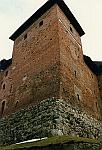 |
One of the
corner fortress towers of Häme Castle, built between 1480 and
1520. During the reign of Gustavus Vasa and his sons, both the ordinance
and interiors were renewed to keep up with the new stylistic requirements
brought to the North by the Renaissance. The corner fortress towers,
built between 1480 and 1520, were the last extensive building project
at the castle during the Middle Ages. |
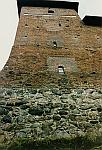 |
Another
view of one of the corner fortress towers of Häme Castle. On
5 June 1659 the castle was ravaged by fire. The wooden structures
were completely destroyed. A record from 1687 shows that most of
the castle was renovated and roofed. |
 |
The original
entrance to the inner castle. It wasn't restored because modifications
the the castle, over the centuries, including the prison, changed
the area so much that the original configuration is not known and
couldn't be determine because of all the changes made. The use of
the castle as a prison started in 1837. The alterations for that
purpose badly disfigured the original architecture. |
 |
A greystone
chamber within the castle, built in the late 13th century. The walls
are original, but the windows and doors have been reconstructed.
The basic design of this area consisted of an area about 45 feet
(14 meters) square, with a series of rooms around it. |
 |
Another
view of a greystone chamber within the castle. The rooms in the
greystone phase are still largely in their original condition. Häme
Castle lost its status as the administrative center of the province
in 1634, when a governor was appointed. From then on, it was merely
a military base where prisoners were kept, commanded by a "Hauptmann"
or commandant instead of a constable. Helsinki became the residence
of the governor. |
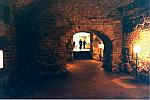 |
The passage
from the greystone chamber to the new main entrance to the castle.
Also, because of Sweden's political and military status, the castle
was not properly cared for. The Great Northern War broke out in
1700, and the castle had to be renovated for defensive purposes.
The work was probably not completed, as the castle was surrendered
to the Russians in 1713, without any resistance. When peace was
restored in 1721, the defense of Finland had been altered, basically
because of the loss of Viipuri. After the Great Northern War the
stronghold was converted into a granary in the 1720s and 1730s,
and raised by one story. |
 |
The original
great hall or Constable's Chamber of the castle from the late 13th
century, used today as a banquet room. Withe the exception of the
doors at the ends, the room has been preserved in its original condition. |
 |
The entry
from the outer courtyard to the inner castle passes passes by the
interior well, which was probably the first construction project
of the castle builders. The well is dry now.
|
 |
The upper
level of the inner courtyard. This area took on this appearance
at the end of the Middles Ages. The ornamentation is from the 15th
century. This is the best preserved area of the brick castle. The
brickwork was uncovered from under a thick layer of plaster which
was added during the time when the castle was a prison.
|
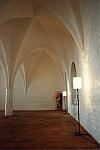 |
Kings Hall, originally the Great Hall. It's original form has
been restored. The original vaulting, from about 1400, had collapsed
or been pulled down. The twin-aisle, six groin vaulting is similar
to that found in Turku Castle.
Like Finland's other "castles of the realm", Häme
Castle and province were governed by a nobleman. All through the
Middle Ages the castle was governed according to feudal principles,
although it belonged to the crown. The castle was usually under
the command of a constable or commandant. Constables appointed
by the king managed Häme Castle. The constables kept accounts
and issued statements on revenue and expenditure for the castle
and province. Preserved accounts from 1539 contain notes on construction
work at the castle, room names and furnishings.
|
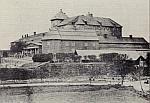 |
The Häme
Castle and its surroundings, from a picture taken in 1869. The castle
surrendered to the Russians on 8 March 1808. In the first decade
of the new autonomous Grand Duchy of Finland, the castle and surrounding
fortifications came under Russian military rule. In the 1810s, the
ramparts (walls and embankments) left unfinished by the Swedes were
completed, and the 16th century western gun tower was pulled down.
The German architect C.L. Engle came up with a plan to further enhance
the castle. In 1953, restoration of Häme Castle began, and
this restoration project has been the largest and most thorough
single restoration project of its kind in Finland. The object of
the restoration project was to restore the castle to what it looked
like before it was employed as a prison in the 19th century. Plans
used to restore Turku and Olavinlinna Castle were followed, with
the main objective being to open the castle to the general public
as a historical monument. The stronghold was opened to the public
on 4 April 1979, with restorating being completed in 1985.
|
 |
An exhibit
in Häme Castle which tells of settlement of Alaska by Finnish
people, on behave of the Russian Empire. The Grand Duchy of Finland,
part of the Russian Empire, existed from the early 1800's until
May 1918.
|
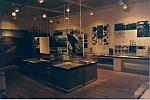 |
An exhibit
in Häme Castle which tells about archealogical projects in
Finland over the past 75 years.
|

